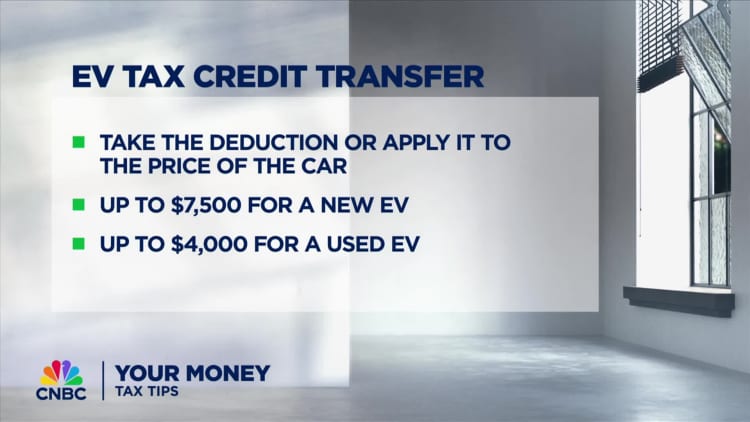Halfpoint Images | Moment | Getty Images
Consumers no longer have to wait to file their annual tax returns to get a tax break for the purchase of a new electric vehicle.
At the start of 2024, the federal “new clean vehicle” tax credit became available as a point-of-sale discount — worth up to $7,500 — at car dealerships.
That means participating dealers can give eligible consumers an immediate break on an EV’s purchase price, perhaps via a partial payment or down payment on the vehicle or a cash payment to buyers.
Buyers of used EV models are also eligible for an upfront price discount from dealers. That tax break for a “previously owned clean vehicle” is worth up to $4,000.
Prior to January, car buyers had to wait until tax season the year following their purchase to claim these tax credits.
Aside from that delay, waiting until tax season carried an additional financial hurdle for consumers because the value of their total EV tax credit couldn’t exceed their annual tax liability, since the credit is “nonrefundable.”
That meant many consumers — especially lower earners, who tend to have smaller tax bills — didn’t qualify for the full $7,500.
Now, participating car dealers can pass along the credit’s full value regardless of a household’s tax liability, so long as the buyer and vehicle meet other eligibility criteria.
“It has so many benefits,” Ingrid Malmgren, policy director at Plug In America, said of the new rules. Plug In America is non-profit educational organization.
Consumers can still opt to receive the financial benefit at tax time instead of receiving it as an advance payment of the tax credit.
Sales reports submitted to the IRS indicate more than 70% of consumers have used the upfront option so far in 2024, according to Jan. 31 remarks from Lily Batchelder, assistant secretary for tax policy at the U.S. Treasury Department.
U.S. electric vehicle sales hit a record 1.2 million in 2023, up 46.3% from 2022, according to Kelley Blue Book.
The average consumer paid $50,798 for a new EV in December, down 17.7% from January 2023, Kelley Blue Book said. (That cost includes financial incentives.) By comparison, the average transaction price for all new vehicles in December was $48,759.
Not all EV dealers are participating yet
Maskot | Maskot | Getty Images
The Inflation Reduction Act, a landmark U.S. law to address climate change, turned the EV tax credit into an upfront discount starting in 2024 by creating a so-called “transfer” provision.
Consumers can choose to transfer the value of their tax credit to a car dealer, which would then be reimbursed by the IRS for fronting that money to consumers. The amount provided by dealers must equal the full amount of the tax credit available for the eligible vehicle, according to the Treasury Department.
Dealers must sign up via the IRS Energy Credits Online portal to facilitate these transfers. The Treasury opened registration to dealers and car manufacturers in November.
Not all car dealers have yet signed up. That means qualifying consumers who want an upfront EV discount may not be able to get one, depending on their seller.
As of Feb. 6, more than 11,000 dealers had registered in the IRS portal, according to a Treasury official speaking on background. Of those, 74% — more than 8,200 — are registered to make advance payments of transferred clean vehicle credits to consumers, the official said.
(Those two figures differ for a few reasons, the official said. For one, there’s a minimum 15-day waiting period for dealers to be able to provide point-of-sale discounts after registering. The IRS must also conduct manual reviews in some cases.)
For context, there were 16,839 franchised retail car dealers in the U.S. during the first half of 2023, according to the National Automobile Dealers Association.
There are also roughly 60,000 independent car dealers, which largely sell used cars, according to a 2021 Cox Automotive estimate.
However, not all franchises or independent dealers necessarily sell EVs.
Not all EVs are eligible for a tax credit
And not all EVs are eligible for a tax break.
The Inflation Reduction Act has manufacturing requirements for new EVs that limit (temporarily, most likely) the models that qualify for a full or partial tax break. Dealers who sell non-qualifying models don’t have an incentive to yet sign up for IRS Energy Credits Online, Malmgren said.
There are 27 new EV models currently available for a full or partial tax break in 2024, according to the U.S. Energy Department. They’re manufactured by Chevrolet, Chrysler, Ford, Jeep, Lincoln, Rivian, Tesla and Volkswagen.
At present, there’s not a database where consumers can search for car dealers that have registered to offer a point-of-sale EV discount, Malmgren said.
“There’s not really any way to know, unless it’s listed on the dealer’s website or if you call a dealer,” she said.
Consumers can ask respective dealers if they’re registered with the IRS to offer the point-of-sale tax credits, Malmgren added. Phrased differently, they can also inquire if the dealer offers advance payments of the $7,500 EV tax credit or a transferrable EV tax credit, she said.
Watch out for pitfalls
Not all consumers qualify for a tax break, either.
The EV tax credit carries some eligibility requirements for consumers. Household income must fall below certain thresholds, for example. The requirements vary for new and used EV purchases.
Buyers will need to sign an affidavit at car dealerships affirming their annual income doesn’t exceed certain eligibility thresholds. Making an error would generally require consumers to repay the tax break to the IRS.
Buyers must file an income tax return for the year in which they transfer their EV tax credit to a dealer. Buyers should make sure to get a copy of a successfully submitted seller report from their car dealer, which consumers would then file with their tax return, Malmgren said.
Credit: Source link




